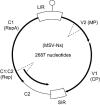Maize streak virus: an old and complex 'emerging' pathogen
- PMID: 20078771
- PMCID: PMC6640477
- DOI: 10.1111/j.1364-3703.2009.00568.x
Maize streak virus: an old and complex 'emerging' pathogen
Abstract
Maize streak virus (MSV; Genus Mastrevirus, Family Geminiviridae) occurs throughout Africa, where it causes what is probably the most serious viral crop disease on the continent. It is obligately transmitted by as many as six leafhopper species in the Genus Cicadulina, but mainly by C. mbila Naudé and C. storeyi. In addition to maize, it can infect over 80 other species in the Family Poaceae. Whereas 11 strains of MSV are currently known, only the MSV-A strain is known to cause economically significant streak disease in maize. Severe maize streak disease (MSD) manifests as pronounced, continuous parallel chlorotic streaks on leaves, with severe stunting of the affected plant and, usuallly, a failure to produce complete cobs or seed. Natural resistance to MSV in maize, and/or maize infections caused by non-maize-adapted MSV strains, can result in narrow, interrupted streaks and no obvious yield losses. MSV epidemiology is primarily governed by environmental influences on its vector species, resulting in erratic epidemics every 3-10 years. Even in epidemic years, disease incidences can vary from a few infected plants per field, with little associated yield loss, to 100% infection rates and complete yield loss.
Taxonomy: The only virus species known to cause MSD is MSV, the type member of the Genus Mastrevirus in the Family Geminiviridae. In addition to the MSV-A strain, which causes the most severe form of streak disease in maize, 10 other MSV strains (MSV-B to MSV-K) are known to infect barley, wheat, oats, rye, sugarcane, millet and many wild, mostly annual, grass species. Seven other mastrevirus species, many with host and geographical ranges partially overlapping those of MSV, appear to infect primarily perennial grasses.
Physical properties: MSV and all related grass mastreviruses have single-component, circular, single-stranded DNA genomes of approximately 2700 bases, encapsidated in 22 x 38-nm geminate particles comprising two incomplete T = 1 icosahedra, with 22 pentameric capsomers composed of a single 32-kDa capsid protein. Particles are generally stable in buffers of pH 4-8.
Disease symptoms: In infected maize plants, streak disease initially manifests as minute, pale, circular spots on the lowest exposed portion of the youngest leaves. The only leaves that develop symptoms are those formed after infection, with older leaves remaining healthy. As the disease progresses, newer leaves emerge containing streaks up to several millimetres in length along the leaf veins, with primary veins being less affected than secondary or tertiary veins. The streaks are often fused laterally, appearing as narrow, broken, chlorotic stripes, which may extend over the entire length of severely affected leaves. Lesion colour generally varies from white to yellow, with some virus strains causing red pigmentation on maize leaves and abnormal shoot and flower bunching in grasses. Reduced photosynthesis and increased respiration usually lead to a reduction in leaf length and plant height; thus, maize plants infected at an early stage become severely stunted, producing undersized, misshapen cobs or giving no yield at all. Yield loss in susceptible maize is directly related to the time of infection: infected seedlings produce no yield or are killed, whereas plants infected at later times are proportionately less affected.
Disease control: Disease avoidance can be practised by only planting maize during the early season when viral inoculum loads are lowest. Leafhopper vectors can also be controlled with insecticides such as carbofuran. However, the development and use of streak-resistant cultivars is probably the most effective and economically viable means of preventing streak epidemics. Naturally occurring tolerance to MSV (meaning that, although plants become systemically infected, they do not suffer serious yield losses) has been found, which has primarily been attributed to a single gene, msv-1. However, other MSV resistance genes also exist and improved resistance has been achieved by concentrating these within individual maize genotypes. Whereas true MSV immunity (meaning that plants cannot be symptomatically infected by the virus) has been achieved in lines that include multiple small-effect resistance genes together with msv-1, it has proven difficult to transfer this immunity into commercial maize genotypes. An alternative resistance strategy using genetic engineering is currently being investigated in South Africa.
Useful websites: http://www.mcb.uct.ac.za/MSV/mastrevirus.htm; http://www.danforthcenter.org/iltab/geminiviridae/geminiaccess/mastrevirus/Mastrevirus.htm.
Figures




References
-
- Ammar, E.‐D. , Gargani, D. , Lett, J.M. and Peterschmitt, M. (2009) Large accumulations of maize streak virus in the filter chamber and midgut cells of the leafhopper vector Cicadulina mbila . Arch. Virol. 154, 255–262. - PubMed
-
- Van Antwerpen, T. , McFarlane, S.S. , Buchanan, G.F. , Shepherd, D.N. , Martin, D.P. , Rybicki, E.P. and Varsani, A. (2008) First report of maize streak virus infection of sugarcane in South Africa. Plant Dis. 92, 982. - PubMed
-
- Asanzi, M.C. , Bosque‐Pérez, N.A. , Nault, L.R. , Gordon, D.T. and Thottappilly, G. (1995) Biology of Cicadulina species (Homoptera: Cicadellidae) and transmission of maize streak virus. Afr. Entomol. 3, 173–179.
-
- Autrey, L.J.C. and Ricaud, C. (1983) The comparative epidemiology of two diseases of maize caused by leafhopper‐borne viruses in Mauritius In: Plant Virus Epidemiology (Plumb R.T. and Thresh J.M. eds), pp. 277–285. Oxford: Blackwell.
-
- Bock, K.R. (1982) Geminivirus diseases in tropical crops. Plant Dis. 66, 266–270.
Publication types
MeSH terms
Grants and funding
LinkOut - more resources
Full Text Sources
Research Materials

